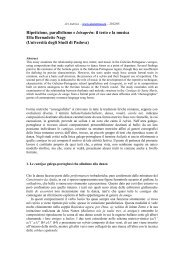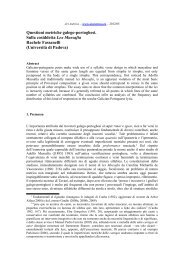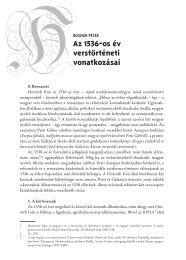The Metrical Structure of Kashmiri Vanɨvun Sadaf ... - Ars Metrica
The Metrical Structure of Kashmiri Vanɨvun Sadaf ... - Ars Metrica
The Metrical Structure of Kashmiri Vanɨvun Sadaf ... - Ars Metrica
Create successful ePaper yourself
Turn your PDF publications into a flip-book with our unique Google optimized e-Paper software.
<strong>Ars</strong> metrica – www.arsmetrica.eu – 2012/05<br />
and determined by a set <strong>of</strong> prosodic rules where there is no necessary one-to-one<br />
correspondence between lexical stress and metrical stress. Thus, a prosodic “word”<br />
can be scanned differently in different verse instances, and this has no bearing,<br />
whatsoever, on the syntax or semantics <strong>of</strong> the verse.<br />
<strong>The</strong> database for the study constitutes <strong>of</strong> fifteen different texts and a number <strong>of</strong><br />
individual verses popularly known among the speakers <strong>of</strong> the <strong>Kashmiri</strong> language<br />
and identified as “<strong>Vanɨvun</strong>” by the native speakers. Most <strong>of</strong> the texts are <strong>of</strong><br />
unknown authorship and are orally preserved, being memorized and passed on from<br />
generation to generation.<br />
<strong>The</strong> remainder <strong>of</strong> the paper is organized as follows. In §2, I present the<br />
sociolinguistic and historical background <strong>of</strong> the poetic genre, along with a note on<br />
how it is performed. In §3, I provide an overview <strong>of</strong> the basic stress pattern in<br />
<strong>Kashmiri</strong> followed by a discussion on the structural aspects <strong>of</strong> <strong>Vanɨvun</strong> in §4 in<br />
terms <strong>of</strong> the verse design (§4.1), delivery or recitation (§4.2), and rhyme scheme<br />
(§4.3). A detailed description <strong>of</strong> the repair mechanisms involved in arriving at a<br />
certain metrical structure is provided in §5, which gives an overall picture <strong>of</strong> the<br />
linguistic means <strong>of</strong> parallel patterning in the form <strong>of</strong> quantity-increasing (§5.1) and<br />
quantity-decreasing (§5.2) strategies. This is followed by a discussion and analysis<br />
<strong>of</strong> the metrically-driven repair mechanisms employed by the composers and their<br />
implications in §6 (i.e., scansions in §6.1, syllable structure in §6.2, and metrical<br />
structure in §6.3), and concluding remarks in §7.<br />
2. Background<br />
As noted earlier, <strong>Vanɨvun</strong> is a genre <strong>of</strong> <strong>Kashmiri</strong> folk poetry which is not<br />
classified as a type <strong>of</strong> bə:t h ‘song’. Historically speaking, it is a form <strong>of</strong> ceremonial<br />
‘chant’ composed <strong>of</strong> sessions which cover sequences <strong>of</strong> rituals associated with<br />
various stages in particular socio-cultural events. Over the course <strong>of</strong> its evolution,<br />
the performance <strong>of</strong> the poetic genre has undergone various changes, including the<br />
adoption <strong>of</strong> a melody, and in the modern times is perceived as a form <strong>of</strong> ‘singing’.<br />
<strong>The</strong>refore, even though historically incorrect, for the purposes <strong>of</strong> this paper, I will<br />
use the term “song” for a (metrically parsed) text in a special sense as a cover term<br />
for any poetic genre in <strong>Kashmiri</strong> that is ‘performed’ or ‘sung’, including <strong>Vanɨvun</strong>. 7<br />
Although little is known about the historical origin <strong>of</strong> <strong>Vanɨvun</strong>, this particular<br />
style <strong>of</strong> poetry is believed to have originated in the Vedic Sanskrit period. It is<br />
highly venerated in <strong>Kashmiri</strong> society. 8 In contrast to the written poetic traditions <strong>of</strong><br />
Kashmir, which have been greatly influenced by and perhaps even adopted from the<br />
poetic traditions in other languages, such as ghazal, nazɨm, marsiya and masnavi<br />
from Urdu and Persian, <strong>Vanɨvun</strong> belongs to the repertoire <strong>of</strong> oral traditions which<br />
are indigenous. Other very popular genres <strong>of</strong> indigenous <strong>Kashmiri</strong> oral tradition<br />
include: vacun, rov (or r<strong>of</strong>), č h akɨr, laɖi:-šah, and ba:ɳɖɨ-pə:t h ɨr, among others.<br />
Historically speaking, a poetic instance in all these traditions is ‘performed’ rather<br />
than written and/or ‘read’.<br />
3







